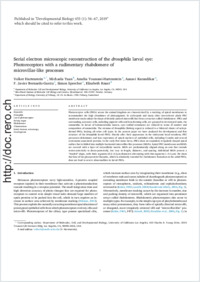Serial electron microscopic reconstruction of the drosophila larval eye: Photoreceptors with a rudimentary rhabdomere of microvillar-like processes
- Hartenstein, Volker Department of Molecular Cell and Developmental Biology, University of California Los Angeles, USA
- Yuan, Michaela Max-Planck-Institute of Molecular Cell Biology and Genetics, Dresden, Germany
- Younossi-Hartenstein, Amelia Department of Molecular Cell and Developmental Biology, University of California Los Angeles, USA
- Karandikar, Aanavi Department of Molecular Cell and Developmental Biology, University of California Los Angeles, USA
- Bernardo-Garcia, F. Javier Department of Biology, University of Fribourg, Switzerland
- Sprecher, Simon G. Department of Biology, University of Fribourg, Switzerland
- Knust, Elisabeth Max-Planck-Institute of Molecular Cell Biology and Genetics, Dresden, Germany
-
01.09.2019
Published in:
- Developmental Biology. - 2019, vol. 453, no. 1, p. 56–67
English
Photoreceptor cells (PRCs) across the animal kingdom are characterized by a stacking of apical membranes to accommodate the high abundance of photopigment. In arthropods and many other invertebrate phyla PRC membrane stacks adopt the shape of densely packed microvilli that form a structure called rhabdomere. PRCs and surrounding accessory cells, including pigment cells and lens-forming cells, are grouped in stereotyped units, the ommatidia. In larvae of holometabolan insects, eyes (called stemmata) are reduced in terms of number and composition of ommatidia. The stemma of Drosophila (Bolwig organ) is reduced to a bilateral cluster of subepidermal PRCs, lacking all other cell types. In the present paper we have analyzed the development and fine structure of the Drosophila larval PRCs. Shortly after their appearance in the embryonic head ectoderm, PRC precursors delaminate and lose expression of apical markers of epithelial cells, including Crumbs and several centrosome-associated proteins. In the early first instar larva, PRCs show an expanded, irregularly shaped apical surface that is folded into multiple horizontal microvillar-like processes (MLPs). Apical PRC membranes and MLPs are covered with a layer of extracellular matrix. MLPs are predominantly aligned along an axis that extends ventro-anteriorly to dorso-posteriorly, but vary in length, diameter, and spacing. Individual MLPs present a “beaded” shape, with thick segments (0.2–0.3 μm diameter) alternating with thin segments (>0.1 μm). We show that loss of the glycoprotein Chaoptin, which is absolutely essential for rhabdomere formation in the adult PRCs, does not lead to severe abnormalities in larval PRCs.
- Faculty
- Faculté des sciences et de médecine
- Department
- Département de Biologie
- Language
-
- English
- Classification
- Biological sciences
- License
- License undefined
- Identifiers
-
- RERO DOC 327385
- DOI 10.1016/j.ydbio.2019.05.017
- Persistent URL
- https://folia.unifr.ch/unifr/documents/308106
Statistics
Document views: 82
File downloads:
- spr_sem.pdf: 163
